Position: Full sun to light shade
Flowering period: Late spring
Soil: Moist, well drained
Eventual Height: 30cm
Eventual Spread: 20cm
Hardiness: 6a, 6b, 7a, 7b, 8a, 8b, 9a
Family: Liliaceae
Erythronium hendersonii is a deciduous herbaceous, perennial with a clump forming habit. Its dark green, brown/ white mottled leaves appear in pairs, are lanceolate to ovate with wavy entire margins, up to 25cm long and 6cm broad. Its pale violet fragrant flowers have dark purple centres, are Lilly like, up to 35mm across and appear on naked stalks. Its roots emerge from an oval shaped bulb which is up to 55mm across.
Erythronium hendersonii, commonly known as the Henderson’s Fawn Lily, is native to the central region of coastal west USA. In its native habitat it grows in dry woodlands and woodland openings.
The etymological root of the binomial name Erythronium is derived from the Greek erythros meaning ‘red’, as to what the red refers to in this species we are unclear. Hendersonii is named after Louis Forniquet Henderson (1853 – 1942), an American botanist.
The landscape architect may find Erythronium hendersonii useful in shady locations including woodlands.
Ecologically, Erythronium hendersonii flowers are attractive to pollinating insects.
Erythronium hendersonii prefers moist, humus rich fertile, well-drained soils. It tolerates most pH of soil.
Erythronium hendersonii requires little maintenance. Large clumps may be divided after flowering.







Leave a comment